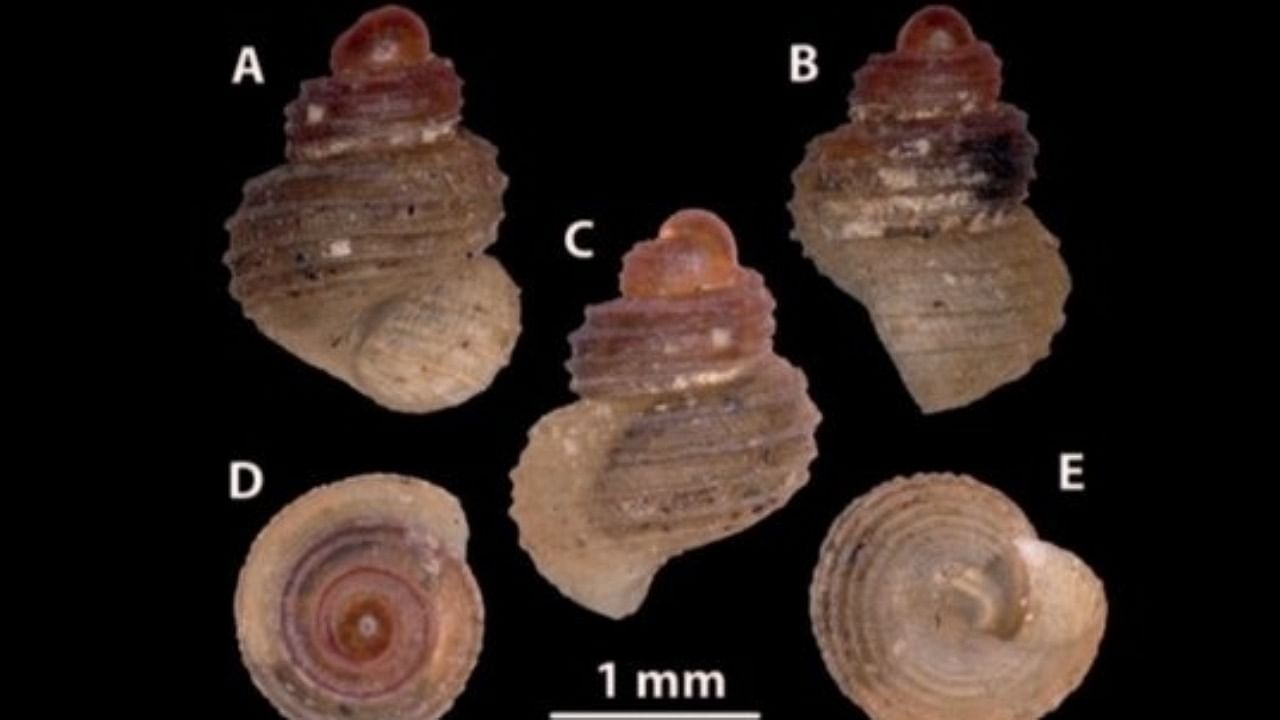
The scientists, who recently discovered a new micro snail species with less than 2 mm in length (adult) in a Meghalaya cave, are conducting a study on mollusc across northeast under a mega project funded by the Department of Biotechnology under the Central government.
Scientists Nipu Kumar Das and NA Aravind, both associated with the Bengaluru-based Ashoka Trust for Research in Ecology and Environment (ATREE), recently discovered the new micro snail species, found deep inside a limestone cave at Mawsmai village in Meghalaya's East Khasi Hills district.
"We have named this species after the limestone cave. Our species Georissa mawsmaiensis is unique from Georissa sarrita, the closest congener (meaning other members of the same genus), which was earlier described from the Mawsmai valley of Meghalaya, in its shell morphology starting from shell size variation to the presence of four very prominent spiral striations on body whorls of the shell (counting from the suture to aperture, in apertural view), compared to seven in Georissa sarrita," Das told IANS.
He said the team compared the morphological characters of the collected snails on the moist limestone rocks, 4-5 metre inside the cave entrance.
"However, at present, we don't know whether our species is a true cave species. Further extensive surveys may reveal more interesting facts about natural history, its true distributional patterns, and so on."
According to ATREE, a Bengaluru-based research institution on biodiversity conservation and sustainable development, the micro snail species was discovered 170 years after the last such discovery was made.
There are a large number of caves in different northeastern states, including Meghalaya and Mizoram.
Though proper study about the flora and fauna available inside these caves has not been done yet, the Geological Survey of India (GSI) has identified certain geological sites across northeast India for promotion of geo-tourism.
Das, a resident of Assam, said that the cave has a very unique environment that can harbour unique faunal diversity.
"There are several studies on cave biodiversity from Southeast Asian countries and other parts of the world, which reported various animals, including snails, but very few studies are from Indian caves," he said.
"The rich calcium minerals in limestone caves provide suitable habitat for shell-bearing snails. These caves are very sensitive to the change in environmental conditions resulting from anthropogenic activities (mining, cave tourism etc.), climate change, and so on, causing negative impacts on cave-dwelling animals," he added.
Das said that in the case of the Mawsmai cave in Meghalaya, one of the major tourist attractions in the state, some changes have been made to increase the aesthetics of the cave, such as artificial lights and cemented floor and steps.
According to the scientist, these anthropogenic changes along with high tourist influx may pose a threat to this micro snail species, as well as other cave biodiversities.
"Till now, only five snail species have been reported from Meghalayan caves, while there may be many more awaiting discovery. Even though there are so many limestone caves in Meghalaya, very few studies have been conducted on snails from these caves. More studies would help us understand the snail diversity present in these unique cave ecosystems," Das said.
He said that the scientists have redescribed a micro snail species named Acmella tersa from the Mawsmai cave in Meghalaya from the newly-collected specimens to provide better diagnostic characters for the genus Acmella.
Since Acmella tersa is the type species of the genus Acmella, the description of the genus Acmella is based upon this particular species.
"Further, we have also assessed the conservation status of the species, and categorised it as Critically Endangered (CR) B1 and B2 according to IUCN (International Union for Conservation of Nature) criteria," he said.
Das said that from 2018, they are conducting a survey on mollusc across the northeast region under a mega project funded by the Department of Biotechnology, and the study would be completed next year.
"Bioresources and Sustainable Livelihoods in Northeast India" is an initiative towards strengthening both science and sustainable development in northeast India.
Funded by the Department of Biotechnology, this multi-institutional, multi-investigator research programme is coordinated by ATREE and Institute of Bioresources and Sustainable Development (IBSD) in partnership with 12 institutions of the northeast.
The Himalayan mountain range that covers much of northeast India is one of the most important and most threatened global biodiversity hotspots.
According to the experts, the region has been a centre of evolutionary novelty, harboring thousands of species found nowhere else on earth.
The northeast region is also home to hundreds of indigenous ethnic communities, with their associated languages and cultures.
Millions of people here rely on bioresources, including ecosystem services, to sustain their livelihoods. Such resources and their enhancement are going to be of vital importance in this era of global climate change.
Of around the 50 million population in the northeast region, 28 per cent are tribals and the majority of them are traditionally dependent on the forest and environment and their resources.
Watch the latest DH Videos here: